Investigating desert labyrinths said to be ancient ceremonial centers.
Investigating Desert Labyrinths Said to Be Ancient Ceremonial Centers
Across various arid landscapes of the world, a series of enigmatic structures known as desert labyrinths have long captivated archaeologists and historians. These intricate earthworks, often found in remote desert regions, are believed to hold significant cultural and spiritual importance to ancient civilizations. This article explores the characteristics, historical context, and ongoing research related to these ancient ceremonial centers, highlighting notable examples and their implications.
What Are Desert Labyrinths?
Desert labyrinths are complex layouts often built from stones, soil, or earth, forming patterns that can range from simple circles to elaborate mazes. e structures have been discovered in various deserts around the world, including the U.S. Southwest, the Arabian Peninsula, and parts of Africa. The design and scale of these labyrinths can indicate their functions, which are primarily thought to be ceremonial or ritualistic, serving as sites for worship, gatherings, or astronomical observation.
Historical Background
The earliest known desert labyrinths have been traced back to prehistoric cultures. For example, in the American Southwest, the Hopi and Pueblo peoples constructed labyrinth-like structures as early as 1000 BCE. These sites provided not only functional spaces for community gatherings but also acted as significant spiritual venues tied to their cosmology and connection to nature.
In the Arabian Desert, similar labyrinths known as “kites†date back to around 3000 BCE. These structures, often made up of large stone walls that narrow at one end, are presumed to have been used for hunting purposes, luring animals to their doom in a dramatic manner. intricacies of these designs illustrate the architectural prowess and the understanding of environmental dynamics by these ancient peoples.
Notable Examples of Desert Labyrinths
Several key sites exemplify the architectural achievements and ceremonial roles of desert labyrinths:
- Chaco Canyon, New Mexico: This UNESCO World Heritage Site showcases a complex of ancient pueblos and ceremonial structures. Archaeological evidence suggests that the layout of Chaco Canyon aligns with astronomical events, underpinning its role as a ceremonial hub.
- The Desert Kites of Jordan: These large, stone-built structures spread across the landscape have been dated back to the Neolithic period and are believed to have functioned as traps for large game, demonstrating a communal effort in hunting rituals.
- Catalhoyuk, Turkey: An intricate settlement that includes labyrinthine pathways, it dates back to 7500 BCE. Its complex urban layout is often interpreted as a ceremonial center that may have reflected the social and spiritual life of its inhabitants.
The Function and Significance of Labyrinths
The functions of desert labyrinths extend beyond mere architectural curiosities. likely served multifaceted purposes. For example, some researchers propose that the labyrinths were designed for:
- Ceremonial Purposes: Many labyrinths are thought to be linked to rituals such as initiation, healing, or seasonal celebrations that connect communities to their deities and the earth.
- Astronomical Alignment: Some structures appear to have been aligned with celestial bodies, suggesting they were used for astronomical observation, helping ancient civilizations track seasons crucial for agriculture.
- Social Cohesion: By providing a communal space, these labyrinths likely fostered social interaction among tribes, aiding in the development of shared cultural identities.
Ongoing Research and Discoveries
Archaeological investigations continue to yield new findings about these complex structures. For example, advancements in remote sensing technology have allowed researchers to unearth previously concealed sites in desert terrains, offering fresh insights into ancient practices. use of LiDAR (Light Detection and Ranging) in the past decade has revealed hidden landscapes and unveiled extensive labyrinth networks.
Challenges and Future Directions
Despite the exciting discoveries, studying desert labyrinths poses unique challenges. Environmental factors such as erosion, climate change, and human encroachment threaten their preservation. To combat these issues, collaboration between archaeologists, governments, and local communities is essential for effective conservation efforts.
Conclusion
Desert labyrinths stand as compelling testaments to the ingenuity and spiritual devotion of ancient peoples. As researchers continue to delve deeper into the past, these structures offer glimpses into the lives of civilizations that once flourished in some of the harshest environments on Earth. The study of these archaeological wonders not only enhances our understanding of ancient cultures but also emphasizes the importance of preserving our shared human heritage.
For those interested in archaeology or ancient cultures, engaging with the ongoing research into desert labyrinths can reveal profound connections between the past and present. Preservation, public education, and advocacy are essential for maintaining these historical sites for future generations to appreciate and learn from.



